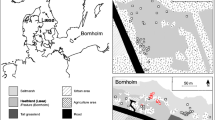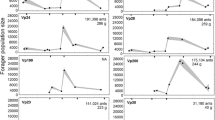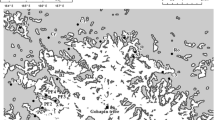Abstract
Social insects are among the most successful and damaging of invasive taxa. We studied spatial and temporal variation in two traits, colony genetic structure and worker mass, associated with social insect success in the introduced fire ant Solenopsis invicta. Our aim was to determine if changes in social structure occurred over time and if variation in worker size was related to worker genotype. We sampled 1139 workers from five multiple-queen S. invicta nests on six dates over a one-year period. The genotypes of workers were determined at ten microsatellite loci and at the selected locus general protein-9 (Gp-9). We found little evidence for genetic differentiation of workers sampled from distinct nests or from different dates at the microsatellite loci. However, worker Gp-9 genotype frequencies varied among nests and over time. In addition, worker mass was affected by nest-of-origin, sampling date, ploidy level, and Gp-9 genotype. Our results suggest that large numbers of queens contribute to the production of workers in introduced S. invicta nests throughout the year. Colony boundaries are semi-permeable, although the among-nest variation in Gp-9 genotype frequencies and worker mass does suggest that boundaries are present. In addition, selection operating on Gp-9 genotype depends on nest environment. Finally, worker mass is affected by both endogenous and exogenous factors in S. invicta. Overall, our data suggests that the key traits of colony social structure and worker size reflect the effects of variable selection in invasive social insects.

Similar content being viewed by others
References
Adams ES, Tschinkel WR (2001) Mechanisms of population regulation in the fire ant Solenopsis invicta: an experimental study. J Anim Ecol 70:355–369
Bourke AFG, Franks NR (1995) Social evolution in ants. Princeton University Press, Princeton
Cahan SH, Vinson SB (2003) Reproductive division of labor between hybrid and nonhybrid offspring in a fire ant hybrid zone. Evolution 57:1562–1570
Calabi P, Porter SD (1989) Worker longevity in the fire ant Solenopsis invicta: ergonomic considerations of correlations between temperature, size and metabolic rates. J Ins Phys 35:643–649
Callcott AMA, Collins HL (1996) Invasion and range expansion of imported fire ants (Hymenoptera: Formicidae) in North America from 1918–1995. Florida Entomol 79:240–251
Callcott AMA, Oi DH, Collins HL, Williams DF, Lockley TC (2000) Seasonal studies of an isolated red imported fire ant (Hymenoptera : Formicidae) population in eastern Tennessee. Env Entomol 29:788–794
Chapman RE, Bourke AFG (2001) The influence of sociality on the conservation biology of social insects. Ecol Lett 4:650–662
Chapuisat M, Bocherens S, Rosset H (2004) Variable queen number in ant colonies: no impact on queen turnover, inbreeding, and population genetic differentiation in the ant Formica selysi. Evolution 58:5
Chen YP, Lu LY, Skow LC, Vinson SB (2003) Relatedness among co-existing queens within polygyne colonies of a Texas population of the fire ant, Solenopsis invicta. Southwestern Entomol 28:27–36
Clapperton BK, Tilley JAV, Beggs JR, Moller H (1994) Changes in the distribution and proportions of Vespula vulgaris (L.) and Vespula germanica (Fab.) (Hymenoptera: Vespidae) between 1987 and 1990 in New Zealand. NZ J Zool 21:295–303
Crozier RH, Kaufmann B, Carew ME, Crozier YC (1999) Mutability of microsatellites developed for the ant Camponotus consobrinus. Mol Ecol 8:271–276
Crozier RH, Pamilo P (1996) Evolution of social insect colonies: sex allocation and kin selection. Oxford University Press, Oxford
Davis LR, Vander Meer R, Porter SD (2001) Red imported fire ants expand their range across the West Indies. Florida Entomol 84:735–736
DeHeer CJ (2002) A comparison of the colony-founding potential of queens from single- and multiple-queen colonies of the fire ant Solenopsis invicta. Anim Behav 64:655–661
DeHeer CJ, Goodisman MAD, Ross KG (1999) Queen dispersal strategies in the multiple-queen form of the fire ant Solenopsis invicta. Am Nat 153:660–675
DeHeer CJ, Vargo EL (2004) Colony genetic organization and colony fusion in the termite Reticulitermes flavipes as revealed by foraging patterns over time and space. Mol Ecol 13:431–441
Goodisman MAD, DeHeer CJ, Ross KG (2000a) Unusual behavior of polygyne fire ant queens on nuptial flights. J Ins Behav 13:455–468
Goodisman MAD, Mack PD, Pearse DE, Ross KG (1999) Effects of a single gene on worker and male body mass in the fire ant Solenopsis invicta (Hymenoptera: Formicidae). Ann Entomol Soc Am 92:563–570
Goodisman MAD, Ross KG (1996) Relationship of queen number and worker size in polygyne colonies of the fire ant Solenopsis invicta. Ins Soc 43:303–307
Goodisman MAD, Ross KG (1997) Relationship of queen number and queen relatedness in multiple-queen colonies of the fire ant Solenopsis invicta. Ecol Entomol 22:150–157
Goodisman MAD, Ross KG (1998) A test of queen recruitment models using nuclear and mitochondrial markers in the fire ant Solenopsis invicta. Evolution 52:1416–1422
Goodisman MAD, Ross KG (1999) Queen recruitment in a multiple-queen population of the introduced fire ant Solenopsis invicta. Behav Ecol 10:428–435
Goodisman MAD, Ross KG, Asmussen MA (2000b) A formal assessment of the effects of gene flow and selection in the fire ant Solenopsis invicta. Evolution 54:606–616
Greenberg L, Vinson SB, Ellison S (1992) Nine-year study of a field containing both monogyne and polygyne red imported fire ants (Hymenoptera: Formicidae). Ann Entomol Soc Am 85:686–695
Henshaw MT, Kunzmann N, Vanderwoude C, Sanetra M, Crozier RH (2005) Population genetics and history of the introduced fire ant, Solenopsis invicta Buren (Hymenoptera: Formicidae), in Australia. Aust J Entomol 44:37–44
Hölldobler B, Wilson EO (1990) The ants. The Belknap Press of Harvard University Press, Cambridge
Holway DA, Lach L, Suarez AV, Tsutsui ND, Case TJ (2002) The causes and consequences of ant invasions. Annu Rev Ecol Syst 33:181–233
Ingram KK (2002) Plasticity in queen number and social structure in the invasive argentine ant (Linepithema humile). Evolution 56:2008–2016
Ingram KK, Gordon DM (2003) Genetic analysis of dispersal dynamics in an invading population of Argentine ants. Ecology 84:2832–2842
Keller L, Ross KG (1998) Selfish genes: a green beard in the red fire ant. Nature 394:573–575
Keller L, Ross KG (1999) Major gene effects on phenotype and fitness: the relative roles of Pgm-3 and Gp-9 in introduced populations of the fire ant Solenopsis invicta. J Evol Biol 12:672–680
Krieger MJB, Keller L (1997) Polymorphism at dinucleotide microsatellite loci in fire ant (Solenopsis invicta) populations. Mol Ecol 6:997–999
Krieger MJB, Ross KG (2002) Identification of a major gene regulating complex social behavior. Science 295:328–332
Krieger MJB, Ross KG, Chang CWY, Keller L (1999) Frequency and origin of triploidy in the fire ant Solenopsis invicta. Heredity 82:142–150
Lewis PO, Zaykin D (2000) Genetic data analysis: computer program for the analysis of allelic data. Version 1.0 (d15).
Lowe S, Browne M, Boudjelas S, De Poorter M (2000) 100 of the world’s worst invasive alien species: a selection from the global invasive species database. Invasive species specialist group
Macom TE, Porter SD (1996) Comparison of polygyne and monogyne red imported fire ant (Hymenoptera: Formicidae) population densities. Ann Entomol Soc Am 89:535–543
McGlynn TP (1999) Non-native ants are smaller than related native ants. Am Nat 154:690–699
Mirenda JT, Vinson SB (1981) Division of labor and specification of castes in the red imported fire ant Solenopsis invicta Buren. Anim Behav 29:410–420
Moller H (1996) Lessons for invasion theory from social insects. Biol Conserv 78:125–142
Oster GF, Wilson EO (1978) Caste and ecology in the social insects. Princeton University Press, Princeton
Pimentel D, Lach L, Zuniga R, Morrison D (2000) Environmental and economic costs of nonindigenous species in the United States. Bioscience 50:53–65
Pinto MA, Rubink WL, Patton JC, Coulson RN, Johnston JS (2005) Africanization in the United States: replacement of feral European honeybees (Apis mellifera L.) by an African hybrid swarm. Genetics 170:1653–1665
Porter SD, Tschinkel WR (1986) Adaptive value of nanitic workers in newly founded red imported fire ant colonies (Hymenoptera: Formicidae). Ann Entomol Soc Am 79:723–726
Queller DC, Goodnight KF (1989) Estimating relatedness using genetic markers. Evolution 43:258–275
Raymond M, Rousset F (1995) GENEPOP (version 1.2): population genetics software for exact tests and ecumenicism. J Hered 86:248–249
Ross KG (1986) Kin selection and the problem of sperm utilization in social insects. Nature 323:798–800
Ross KG (1988) Differential reproduction in multiple-queen colonies of the fire ant Solenopsis invicta (Hymenoptera: Formicidae). Behav Ecol Sociobiol 23:341–355
Ross KG (1993) The breeding system of the fire ant Solenopsis invicta: effects on colony genetic structure. Am Nat 141:554–576
Ross KG (1997) Multilocus evolution in fire ants: effects of selection, gene flow and recombination. Genetics 145:961–974
Ross KG (2001) Molecular ecol of social behaviour: analyses of breeding systems and genetic structure. Mol Ecol 10:265–284
Ross KG, Fletcher DJC (1985) Genetic origin of male diploidy in the fire ant, Solenopsis invicta (Hymenoptera: Formicidae), and its evolutionary significance. Evolution 39:888–903
Ross KG, Keller L (1995) Ecology and evolution of social organization: insights from fire ants and other highly eusocial insects. Annu Rev Ecol Syst 26:631–656
Ross KG, Keller L (1998) Genetic control of social organization in an ant. Proc Natl Acad Sci USA 95:14232–14237
Ross KG, Vargo EL, Keller L (1996) Social evolution in a new environment: the case of introduced fire ants. Proc Natl Acad Sci USA 93:3021–3025
Rousset F, Raymond M (1995) Testing heterozygote excess and deficiency. Genetics 140:1413–1419
Schluns H, Koeniger G, Koeniger N, Moritz RFA (2004) Sperm utilization pattern in the honeybee (Apis mellifera). Behav Ecol Sociobiol 56:458–463
Sokal RR, Rohlf FJ (1995) Biometry. W. H. Freeman and company, New York
Tschinkel WR (1993) Sociometry and sociogenesis of colonies of the fire ant Solenopsis invicta during one annual cycle. Ecol Monogr 63:425–457
Tschinkel WR (1998) The reproductive biology of fire ant societies. Bioscience 48:593–605
Tsutsui ND, Suarez AV (2003) The colony structure and population biology of invasive ants. Conserv Biol 17:48–58
Valles SM, Porter SD (2003) Identification of polygyne and monogyne fire ant colonies (Solenopsis invicta) by multiplex PCR of Gp-9 alleles. Ins Soc 50:199–200
Vargo EL, Porter SD (1989) Colony reproduction by budding in the polygyne form of Solenopsis invicta (Hymenoptera: Formicidae). Ann Entomol Soc Am 82:307–313
Vinson SB (1986) Economic impact and control of social insects. Praeger, New York
Vinson SB (1997) Invasion of the red imported fire ant (Hymenoptera: Formicidae). Am Entomol 43:23–39
Weir BS, Cockerham CC (1984) Estimating F-statistics for the analysis of population structure. Evolution 38:1358–1370
Williams DF (1994) Exotic ants: biology, impact, and control of introduced species. Westview Press, Boulder
Williamson M (1996) Biological invasions. Chapman and Hall, New York
Acknowledgements
We thank J. K. Hatt, E. A. Matthews, and K. G. Ross and for help collecting samples, E. Cook, S Heitner, N. Ueda, and D. Williams for assistance in weighing ants, two anonymous reviewers for helpful comments, and the Georgia Institute of Technology for providing the funds necessary for conducting this research.
Author information
Authors and Affiliations
Corresponding author
Rights and permissions
About this article
Cite this article
Goodisman, M.A.D., Sankovich, K.A. & Kovacs, J.L. Genetic and morphological variation over space and time in the invasive fire ant Solenopsis invicta . Biol Invasions 9, 571–584 (2007). https://doi.org/10.1007/s10530-006-9059-8
Received:
Accepted:
Published:
Issue Date:
DOI: https://doi.org/10.1007/s10530-006-9059-8




